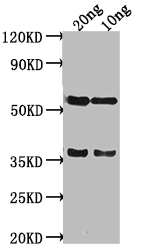The SALM polyclonal antibody is obtained by introducing recombinant Drosophila melanogaster (Fruit fly) SALM protein into a rabbit, which stimulates the production of antibodies that target this particular antigen. Antibody production is further boosted through a booster injection, and the resulting SALM polyclonal antibodies present in the rabbit's serum are collected and purified using protein A/G. Comprehensive testing conducted in ELISA and WB assays has validated the SALM antibody's specific ability to recognize Drosophila melanogaster (Fruit fly) SALM protein.
In Drosophila, the SALM protein is involved in the organization and maturation of synapses, as well as the modulation of synaptic strength. It promotes synapse formation by interacting with other synaptic proteins and promoting their localization to specific regions of the synapse. Additionally, the SALM protein is involved in regulating the balance between excitatory and inhibitory synapses, which is important for proper neural circuit function.







